Six Ways to Create Great First Touchpoint Experiences
Don’t miss the chance to make a strong first impression with your prospects.
As the saying goes, “You never get a second chance to make a good first impression.” But how many companies successfully employ this concept when presenting their brand or products to individuals for the first time?
Your brand creates expectations for your customer — it defines who you are, how you separate yourself from others, and what value you can offer to your customers. These expectations assure your customers that what they expect will be what they actually experience.
By designing and controlling your first touchpoint experience with potential customers, you can grab their attention and encourage them to keep engaging with you beyond their first interaction.
Here are six ways to ensure your first touchpoint experience with customers is a positive one.
1. Make your message clear.
People often struggle to understand what a company does when reading its website copy or social profiles. For example, it’s not uncommon to wonder: “Wait, do they sell data? Do they compile data from other sources? Where is the data coming from, and what are they doing with it? Why is it so confusing?”
Simply put, buzzwords and jargon can get in the way. It can be tempting to rely on buzzwords to make your copy line up with what your industry is talking about, but don’t overdo it. Your audience is human, and their attention spans are limited. They’re not going to spend more than a few minutes trying to decipher what you do before they move on.
So be straightforward in your copy, and speak using language humans actually want to read. Moz, for example, does a nice job of this. Their homepage starts with the headline that shows what they’re all about: “There’s a smarter way to do SEO.”
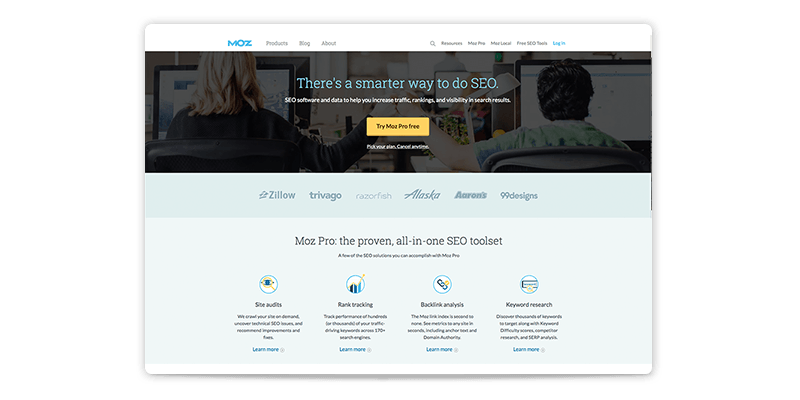
2. Share your brand story or unique positioning.
Once you’ve nailed the message, you need to get that information in front of your first-time site visitors. Some sites bury their “About Us” information in a menu at the bottom of the page, so there’s no guarantee that people who are new to you — those people that could benefit most from knowing your story — will see it.
Personalization technology allows you to use rules to deliver any message you’d like to first-time site visitors. Use the opportunity to share what makes you different. In other words, explain why a person should stay on your website. For example, if you’re a retailer, explain what makes your brand unique and why shoppers should consider making a purchase. If you’re a tech company, explain what you’re an expert in.
As one idea, you can display a callout message indicating your differentiators to new visitors to make sure they don’t miss out. The zoomed-in example below shows a callout that explicitly answers the question of why a prospect should consider this company.
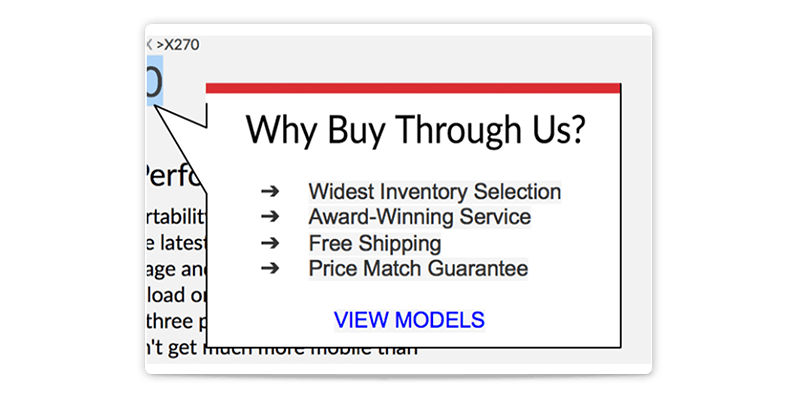
3. Focus on the user experience, not just the sale.
In the last section, we suggested you deliver a potentially interruptive message to a first-time visitor, so now we must offer some words of caution. How many times have you experienced this situation: You land on a website for the first time. Immediately, you’re greeted with a message to accept the site’s cookies. Once you accept, you face a pop-up asking you to join the mailing list. After you decline, you see a second pop-up telling you to give feedback, share the article, take a demo, etc. It’s enough to make you forget why you came to the site in the first place!
Here’s an example of what not to do.
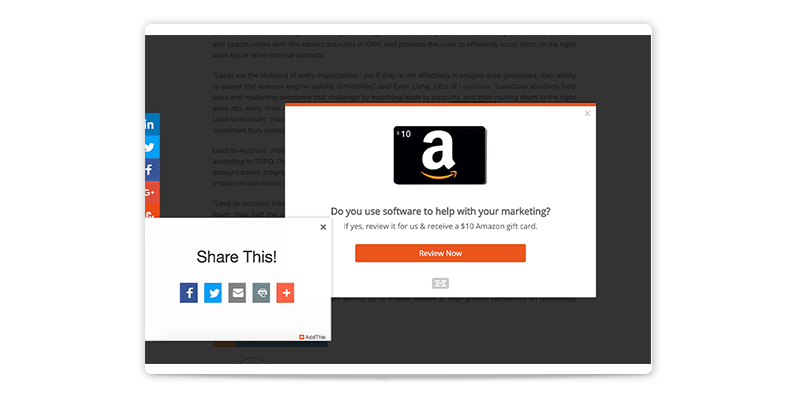
We’re sure you don’t appreciate experiences like this, so it’s safe to assume your visitors don’t either. As you add different messages and run different campaigns, always keep the end user experience in mind. Read “The Secret to Pleasant Pop-ups” for some guidance on presenting more effective pop-up messages.
Ultimately, you need to get your message in front of first-time visitors so you don’t lose them, but approach these messages with caution.
4. Make your homepage personal.
Beyond recognizing that someone is a first-time visitor, there are a few other things you may be able to identify. For example, you can immediately recognize their geolocation, referring source, device type, or browser type, and with reverse IP lookup, you might be able to identify their firmographic details like company name, industry, company size, and more.
Use this information to deliver a relevant homepage experience from the very first moment a person arrives at your site by swapping out headlines, images, and CTAs with ones tailored to them.
How you do this will vary dramatically depending on your business and goals. For instance, geolocation can be a powerful data point to use for personalization (as shown in the example below), but it doesn’t make sense for a business without a location-based message to share.
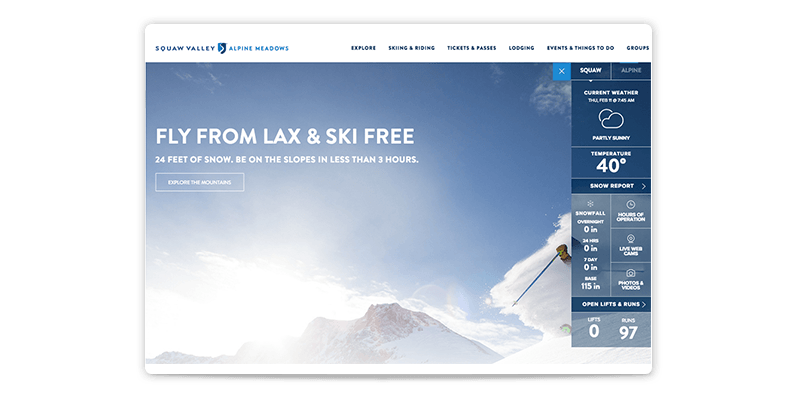
5. Curate relevant content.
Your goal is to help every person on your site find something relevant so they stay longer, dive further into the site, and, ideally, convert — either make a purchase, fill out a form, or however you define conversion. Surfacing helpful content can help you achieve this goal.
Once a person spends time engaging on your site, you should be able to recommend content or products directly related to their interests and in-the-moment intent with machine-learning algorithms. While you may not have quite enough information about a first-time visitor to do this, you can curate content relevant to some of the data points referenced in the last section.
For example, companies often show messages and content aimed at target accounts as part of their account-based marketing (ABM) programs. Whenever a visitor from one of those accounts visits the site, the company could display an infobar welcoming them and offering resources they might appreciate. If the person clicks it, they’re shown a message with content hand-picked for them.
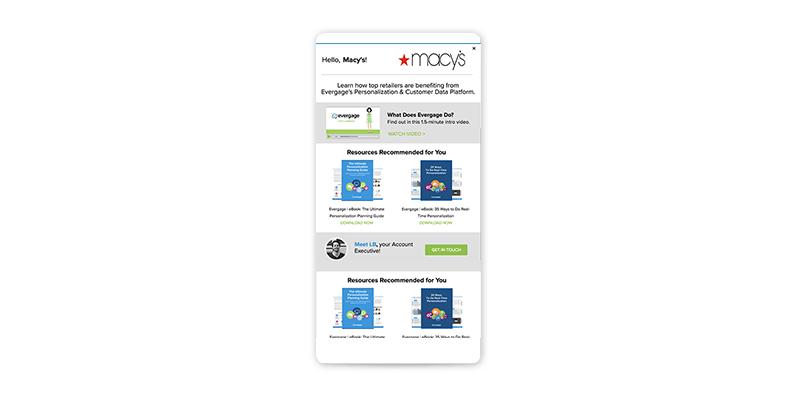
You can approach your content in a similar way. Figure out what information you can identify immediately. Then think about what content you would like to show those visitors that meet that criteria. If you have a few blog posts or e-books targeted to different industries, for example, you can display those the second you recognize someone from that industry.
Surfacing relevant content immediately helps you quickly hook a first-time visitor and drive them further into the site.
6. Ask good questions, and actually use the answers.
You may find occasions when the best way to deliver a good experience is simply to ask someone what they want and actually listen and respond to the answer. In the digital world, survey questions can help with that — when done well, of course.
Think about what information, if you had access to it, would help you provide a better experience to someone interacting with your company for the first time. If you’re a B2C lifestyle brand, maybe this would be a person’s interests or hobbies. If you’re a B2B enterprise technology company, maybe this would be the types of complementary technology a visitor already uses. Figure out one short question you can ask a person that will help you deliver a more relevant experience, and ask it in an unobtrusive way.
Then, most importantly, actually use the response in the moment. Point the visitor to a certain page on your site that can help them with the issue they’re facing, recommend content that addresses their interests, or announce a sale in a relevant category.
When done well, like this bank does in the example below, a simple survey question can emulate the human experience of asking for more information about someone and responding in the moment.
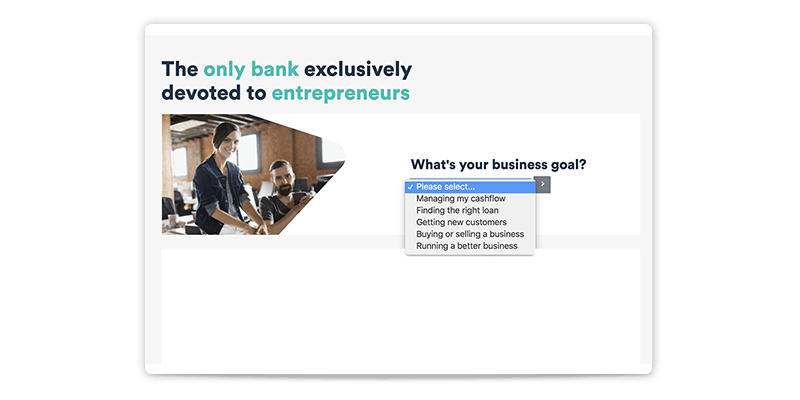
Final thoughts
A good first impression can make the difference between a bounced visitor and a converted customer for life, so don’t neglect this critical component of your marketing strategy. By focusing on your message and user experience, and responding in the moment to inferred and/or explicit data, you can ensure that a person’s first touchpoint experience isn’t their last.
To learn how Marketing Cloud Personalization can help you identify first-time visitors and respond to them with relevant messages and experiences, request a demo today.

Product
Marketing Cloud Personalization

Report
The Gartner Magic Quadrant for Personalization Engines, 2020

Blog
Creating Personalized Content in Marketing Cloud — The Nuts and Bolts

Product
Marketing Cloud Personalization

Report
The Gartner Magic Quadrant for Personalization Engines, 2020

Blog
Creating Personalized Content in Marketing Cloud — The Nuts and Bolts


